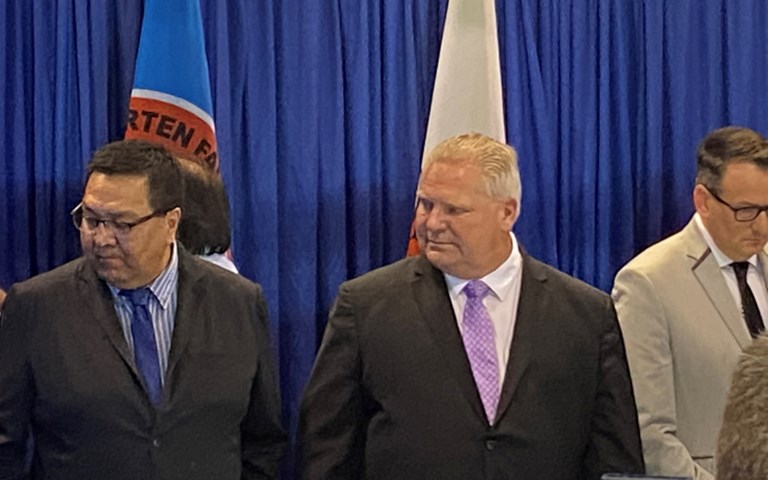Chief Bruce Achneepineskum of the Marten Falls First Nation, Ontario Premier Doug Ford, and Minister of Energy, Northern Development and Mines Greg Rickford
Ontario premier Doug Ford announced on Mar. 2 at the PDAC 2020 convention that the province, Marten Falls First Nation and Webequie First Nation have entered into an agreement to proceed with the construction of an access road to the Ring of Fire region in the James Bay lowlands.
Ford made the announcement during a press conference at the Ontario booth on the convention’s trade floor, and was joined by Greg Rickford, minister of energy, northern development and mines and minister of Indigenous affairs, as well as Chief Bruce Achneepineskum of the Marten Falls First Nation and Chief Cornelius Wabasse of Webequie First Nation for the signing of the agreement.
The Ring of Fire region has been highly sought-after by mineral prospectors for the potential of its chromite, nickel, copper and platinum deposits, which have an estimated value of $60 billion, according to the province. The government, under former premier Kathleen Wynne, had previously announced an agreement to build an access road to the Ring of Fire in August 2017. However, the remoteness of the region, lack of infrastructure and numerous issues with the provinces’ consultation process with the local First Nations had all but halted development in the region.
“Today, we’re taking a crucial step forward in unlocking the multi-billion-dollar opportunity that is in northern Ontario’s Ring of Fire,” Ford said during the press conference. “We’re signing a historic agreement with the Webequie and Marten Falls First Nations to bring jobs, growth [and] long term prosperity to their communities and all Northerners, the likes of which this province has never seen before.”
According to Ford, the road will provide all-season access to the region and its communities, bring jobs to the communities and lead to better health care and social services. Ford also specified that the Ontario government will be investing in broadband infrastructure to bring cellular service and high-speed Internet to the region.
Related: Three First Nations will work with Ontario to build all-season roads to major chromite deposit
When Achneepineskum took the podium, he spoke on the affected First Nations’ priorities, and how the consultation process leading to this agreement was more effective than in the past.
“We need to have meaningful dialogue [and] meaningful participation when it comes to any development that happens in our territories,” Achneepineskum told the attendees. “We’re active participants in resource development. We want to be active participants in resource development opportunities in our lands, our ancestral lands. For us to be true partners, we need the doors open for us. We need a seat at the table to discuss our real concerns, our issues and our plans to move forward in the future.”
“We’ve been talking to these folks for quite a long time, talking about the real concerns in their plans and they’ve been upfront with us from day one,” he added. “It hasn’t been the case in the past… when the industry has come knocking at our doors.”



